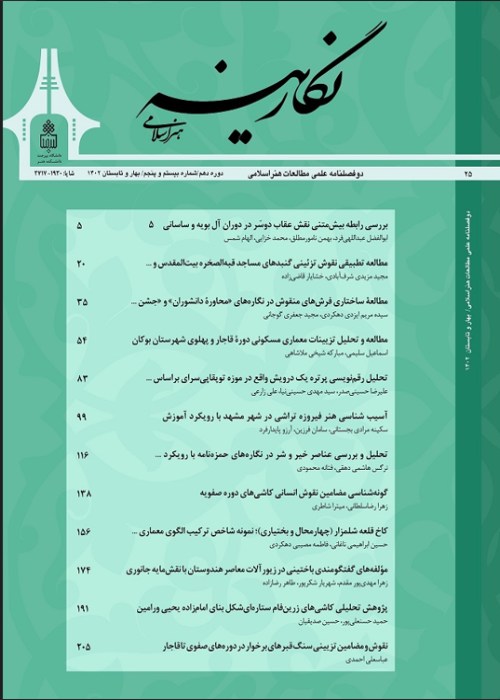Analysis of the Quranic Manuscript of Negel
Author(s):
Article Type:
Research/Original Article (بدون رتبه معتبر)
Abstract:
The Quran of Negel is an ancient copy of the Noble Quran. It is currently kept at Negel village in Sanadaj, Kurdistan Province. Besides looking into the peculiarities of this Quranic manuscript, the present paper attempts to pinpoint its importance and high status among the local population, to explain how it made its way to the village of Negel, to present its historical record, and to describe the type of script used in it and its scribing date as well as its illumination and hair-pin ornamentations. The major research questions are: this Quran scribe within the Iranian cultural geography, in eastern (Iranian) Kufic script, and is it possible to define the timespan in which it was scribed? The hypothesis is that this manuscript was scribed in the Khorasan region in Kufic script in the late fifth-early sixth century AH. The manuscript is in large folio and, as said, in eastern (Iranian) Kufic. Though a number of the first pages are missing, 730 pages have survived including 365 sheets and a leather cover dark brown in color. The paper used is of Samarqand type. Each surat has an inscription containing the name of the surat and the number of its verses. Initial letters of the surats are in two distinct scripts, namely rectangular Kufic and Naskh. The end of each verse is marked by a roundel formed by gilt outlined in black, with takhmis and tashir marks. Given its script type, this manuscript might have been copied in late fifth-early sixth centuries AH. In the end, it appears to have been highly important in terms of its size and scribing method; it seems to have lost one third of its original size. In its original, complete form, the manuscript would have boasted of its tragic splendor, though it still largely preserves that grandeur. The Quran of Negel with the above-mentioned characteristics definitely shows that the scriber, illuminator and in particular the one who commissioned it, though each pursuing a distinct objective, have all played a profound role in persevering and propagating first the Islamic religion and then the calligraphy art and book embellishing. This Quranic manuscript is characterized by its eastern Kufic script which demonstrates the importance of book embellishing at the time it was prepared. The significance of this manuscript is multifold: its size, its use of Piramooz or eastern Kufic script in a very masterly way, its illumination and in general its book embellishing aspect in terms of surat initials and tashir marks, all of which combine to make it unique among the Quranic manuscripts. Finally, its scribal and illumination features may suggest that the Quran of Negel might have been commissioned by a king or at least a local governor in the eastern Iran (Khorasan) in the closing years of the fifth or in the early sixth century AH.
Keywords:
Language:
Persian
Published:
Journal of Negarineh Islamic Art, Volume:1 Issue: 2, 2014
Pages:
4 to 14
magiran.com/p1727162
دانلود و مطالعه متن این مقاله با یکی از روشهای زیر امکان پذیر است:
اشتراک شخصی
با عضویت و پرداخت آنلاین حق اشتراک یکساله به مبلغ 1,390,000ريال میتوانید 70 عنوان مطلب دانلود کنید!
اشتراک سازمانی
به کتابخانه دانشگاه یا محل کار خود پیشنهاد کنید تا اشتراک سازمانی این پایگاه را برای دسترسی نامحدود همه کاربران به متن مطالب تهیه نمایند!
توجه!
- حق عضویت دریافتی صرف حمایت از نشریات عضو و نگهداری، تکمیل و توسعه مگیران میشود.
- پرداخت حق اشتراک و دانلود مقالات اجازه بازنشر آن در سایر رسانههای چاپی و دیجیتال را به کاربر نمیدهد.
In order to view content subscription is required
Personal subscription
Subscribe magiran.com for 70 € euros via PayPal and download 70 articles during a year.
Organization subscription
Please contact us to subscribe your university or library for unlimited access!


